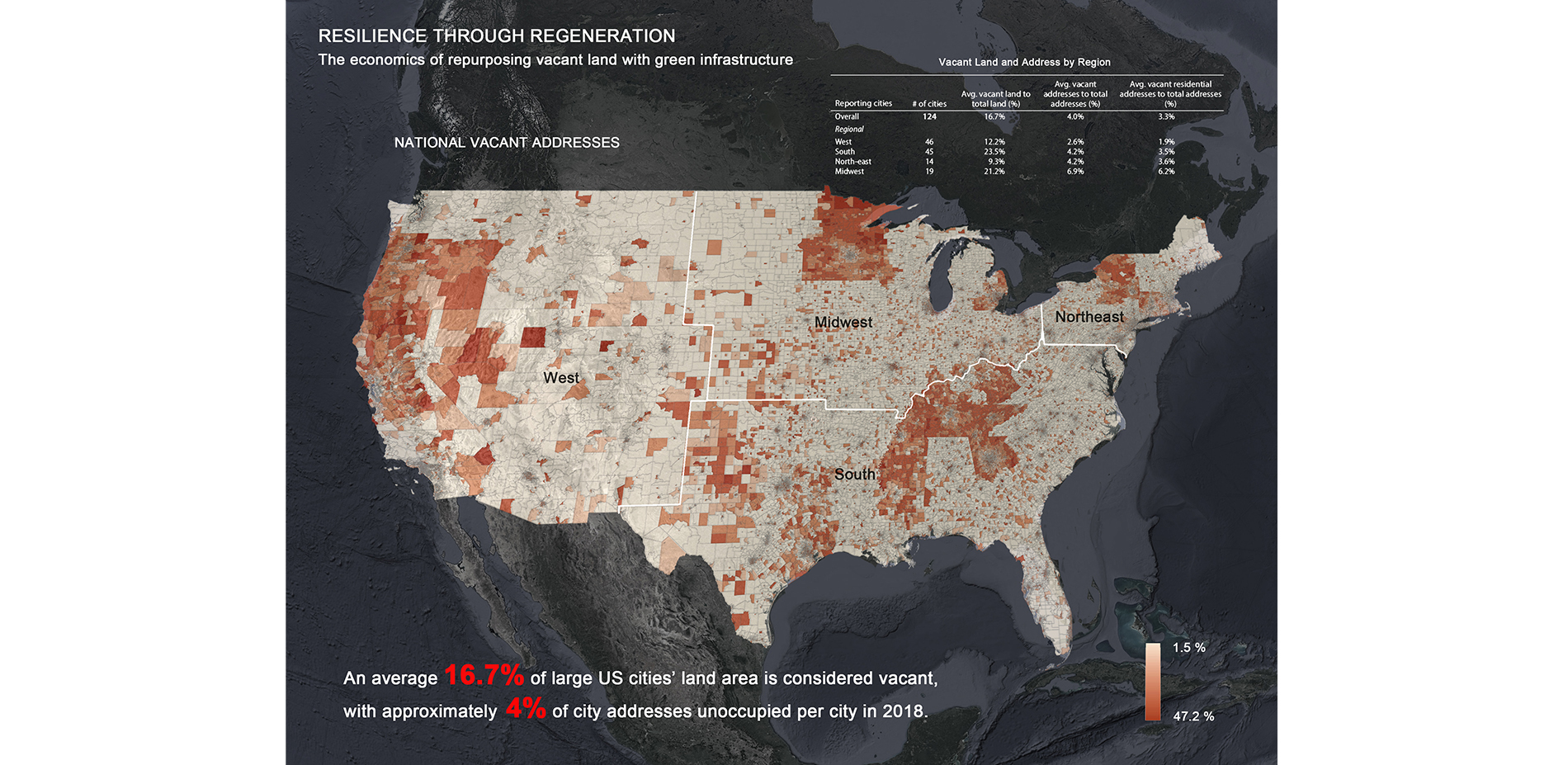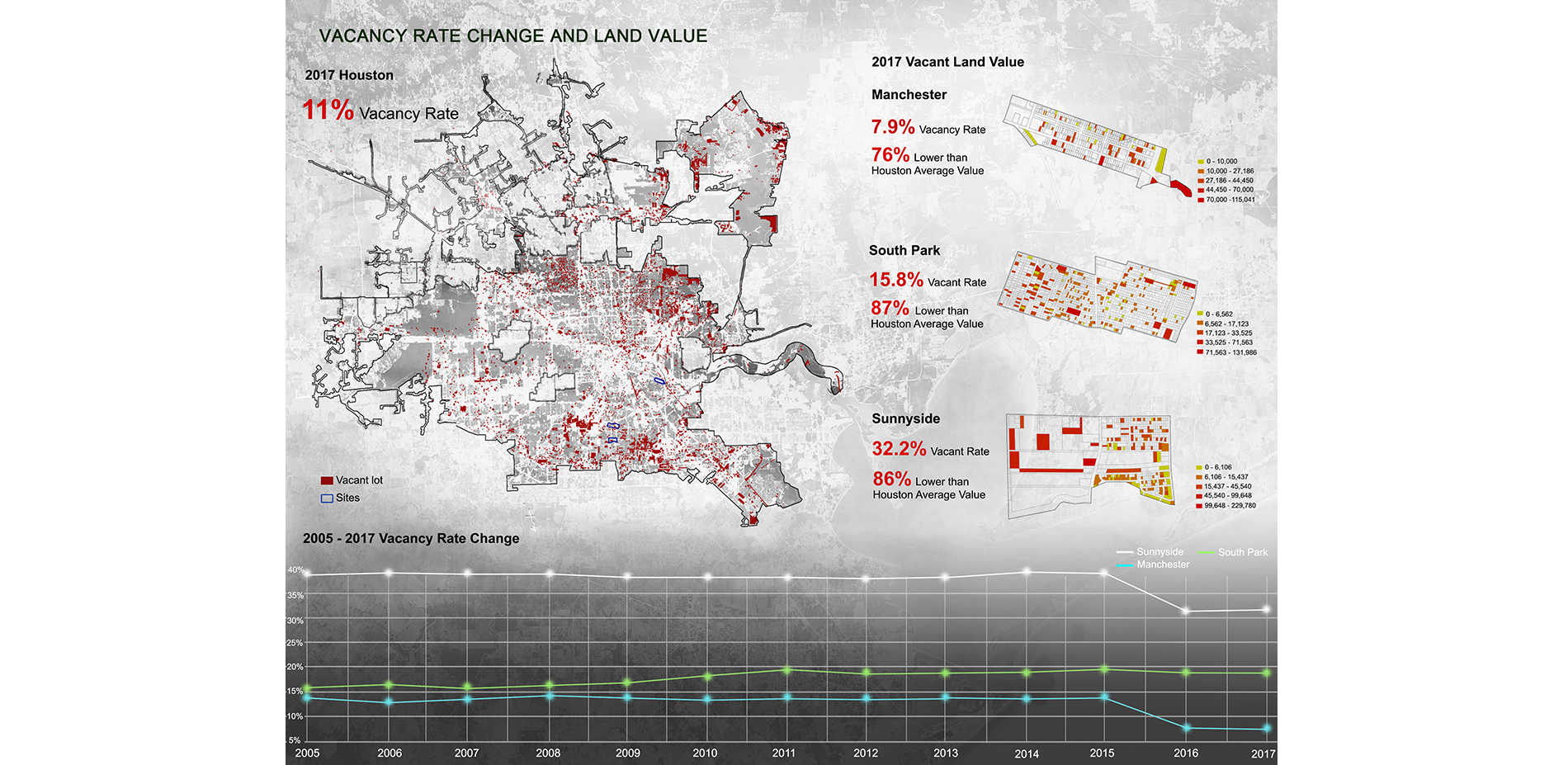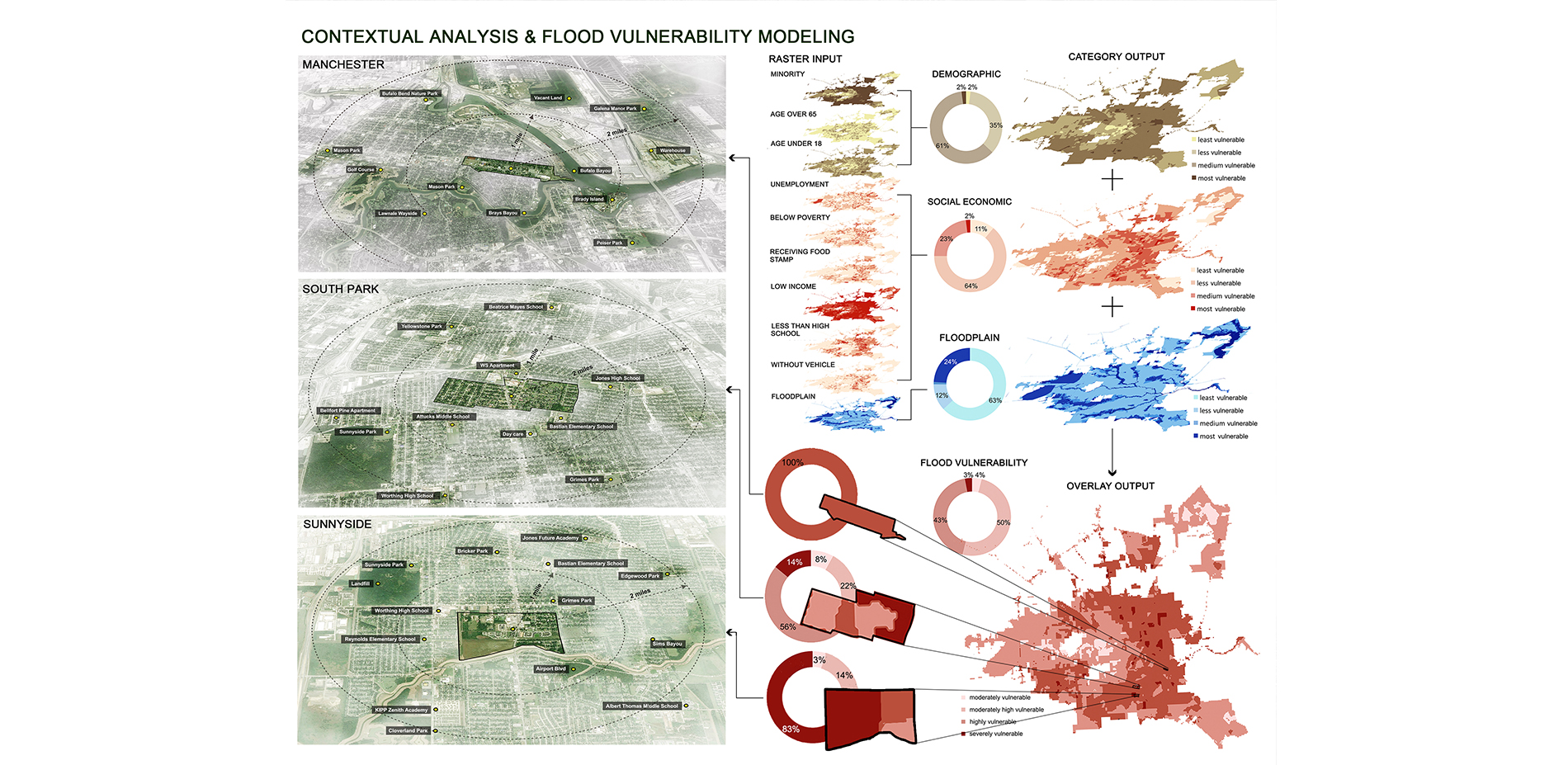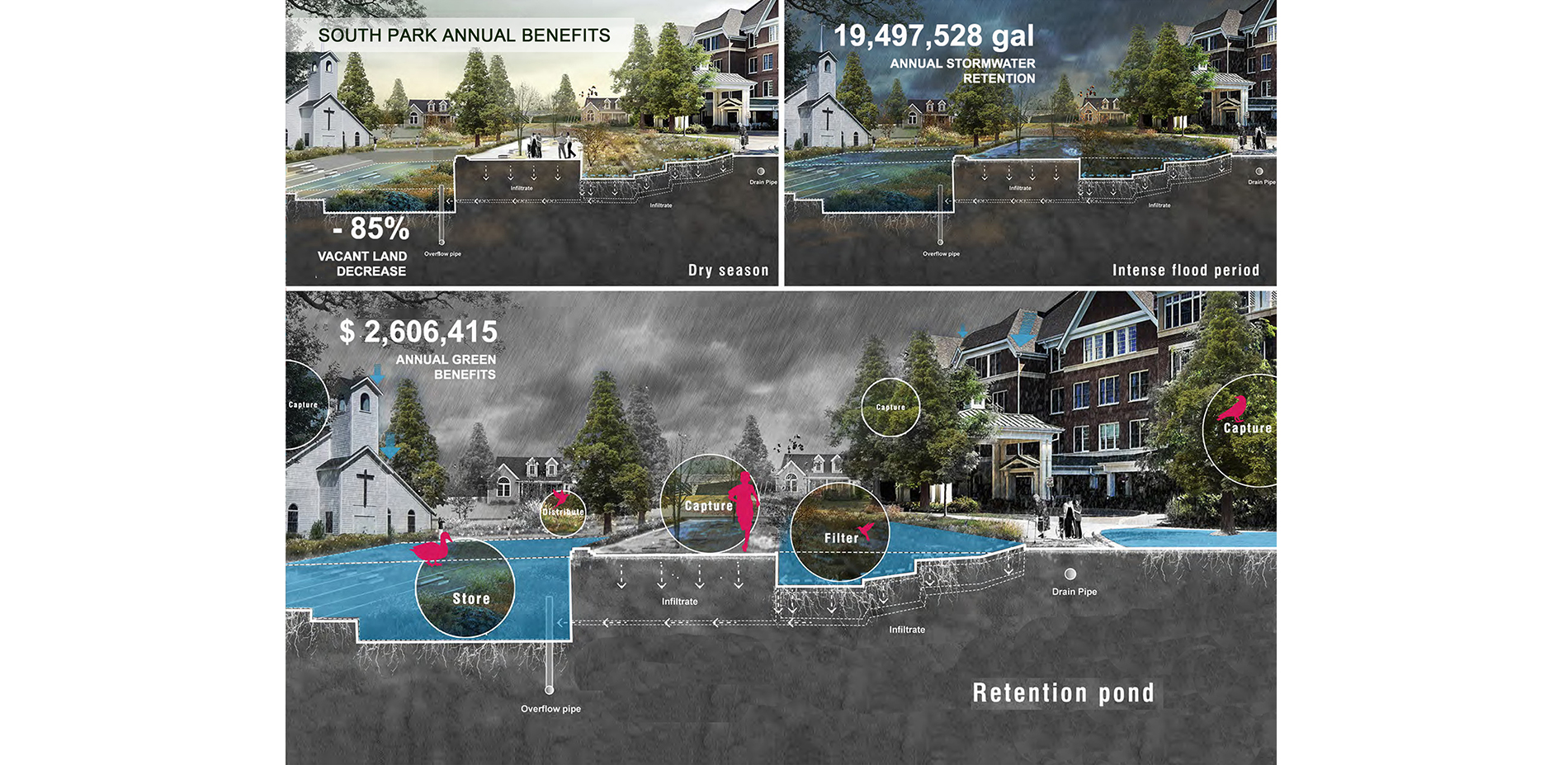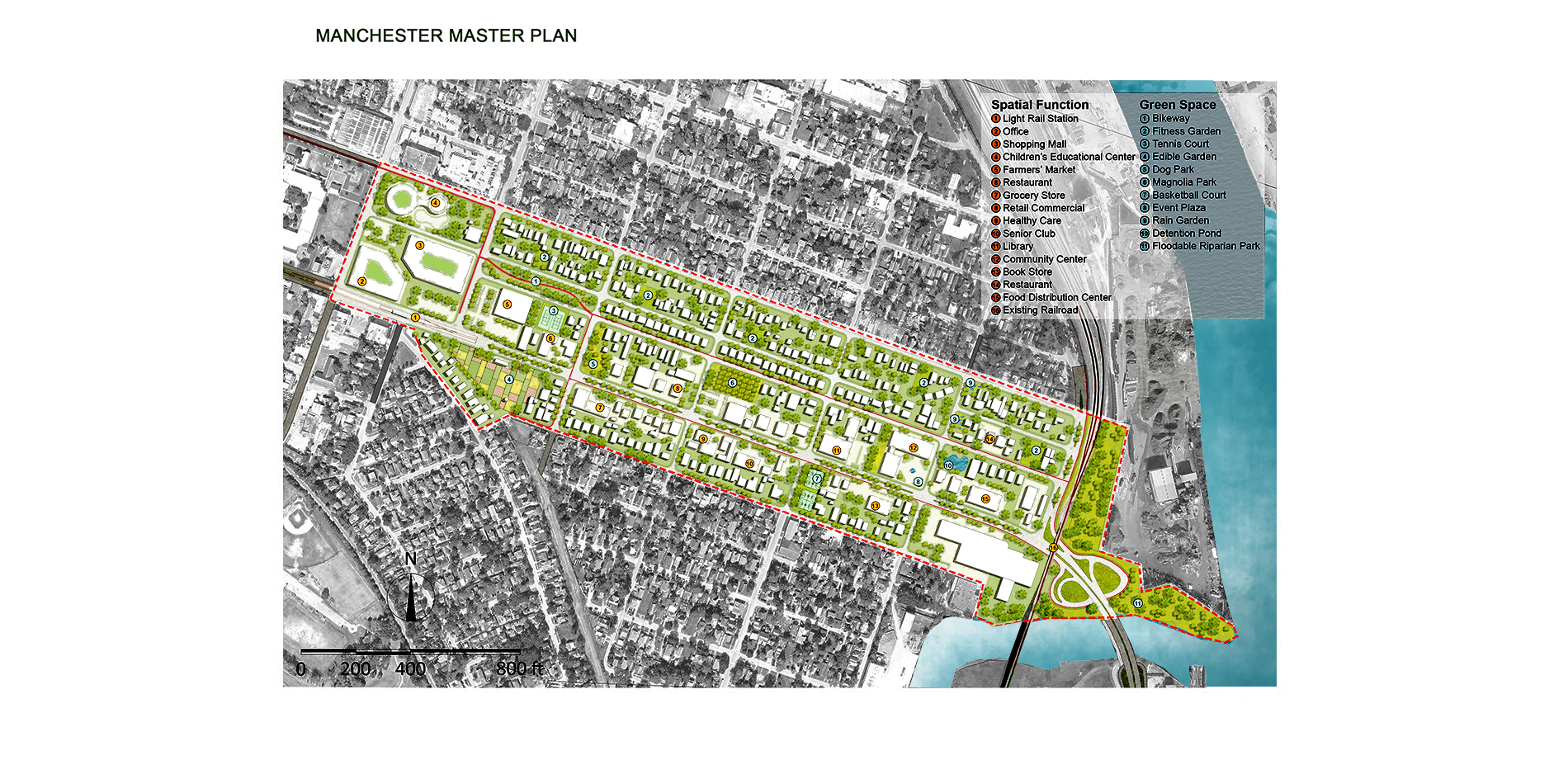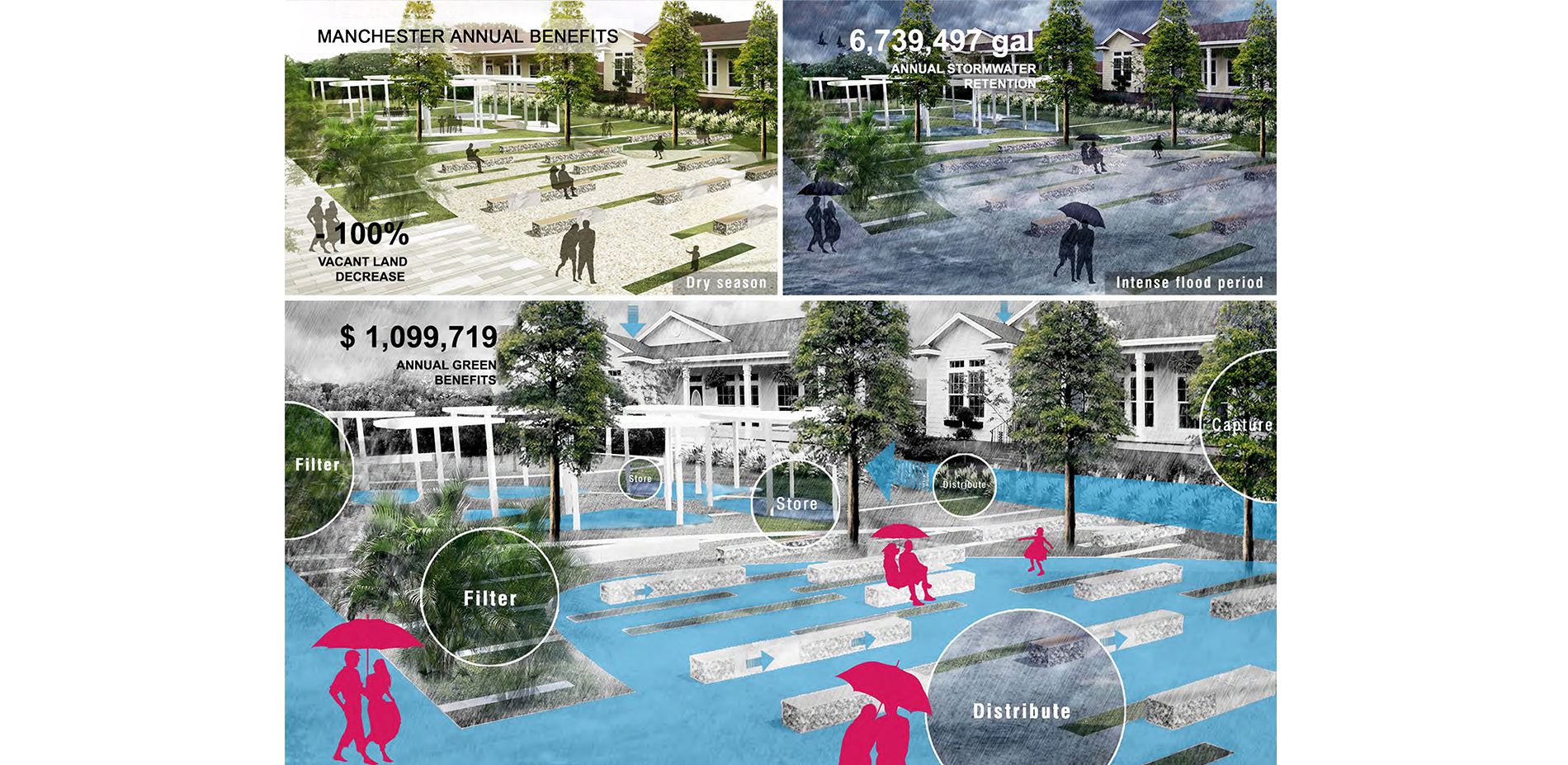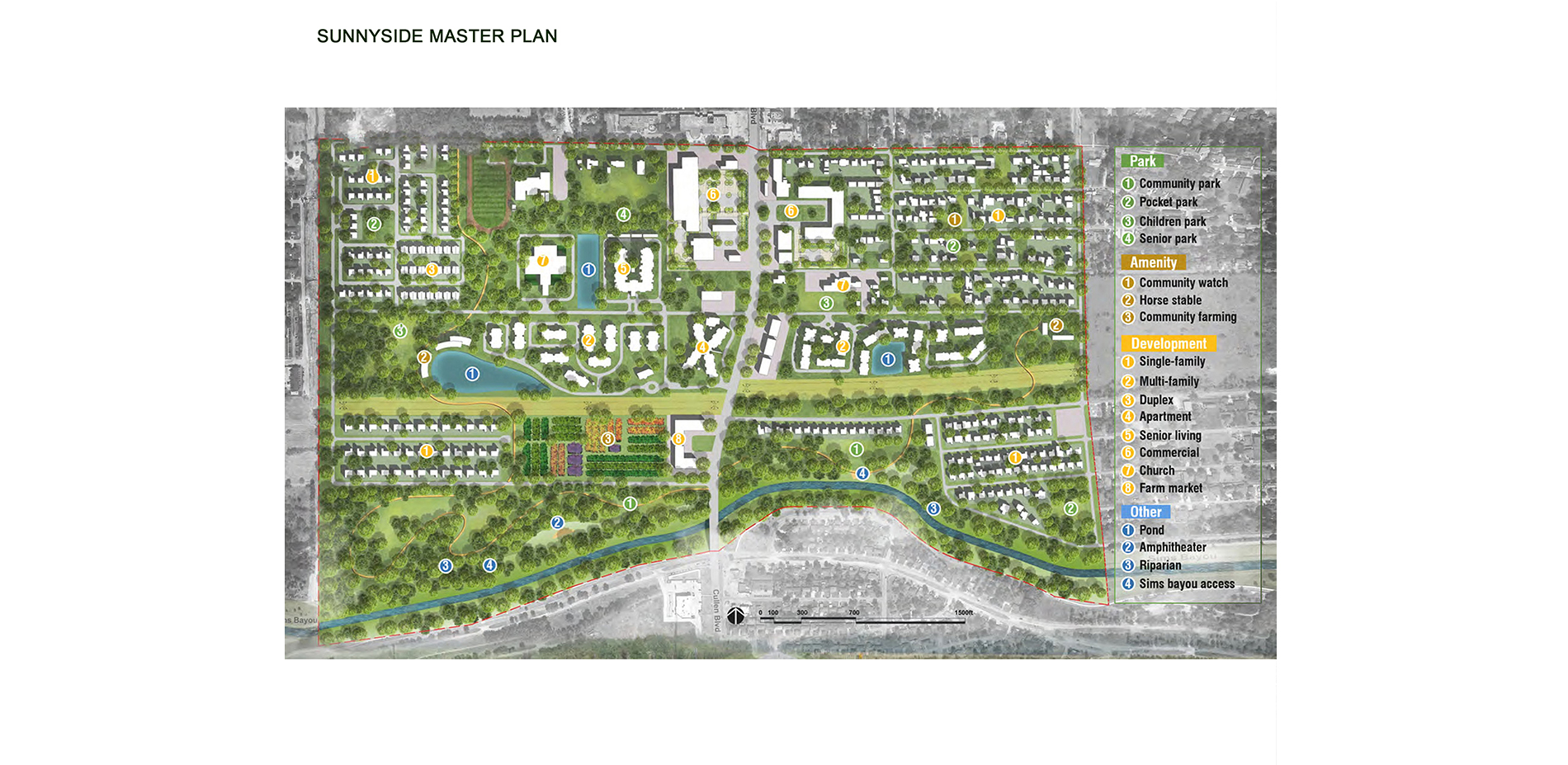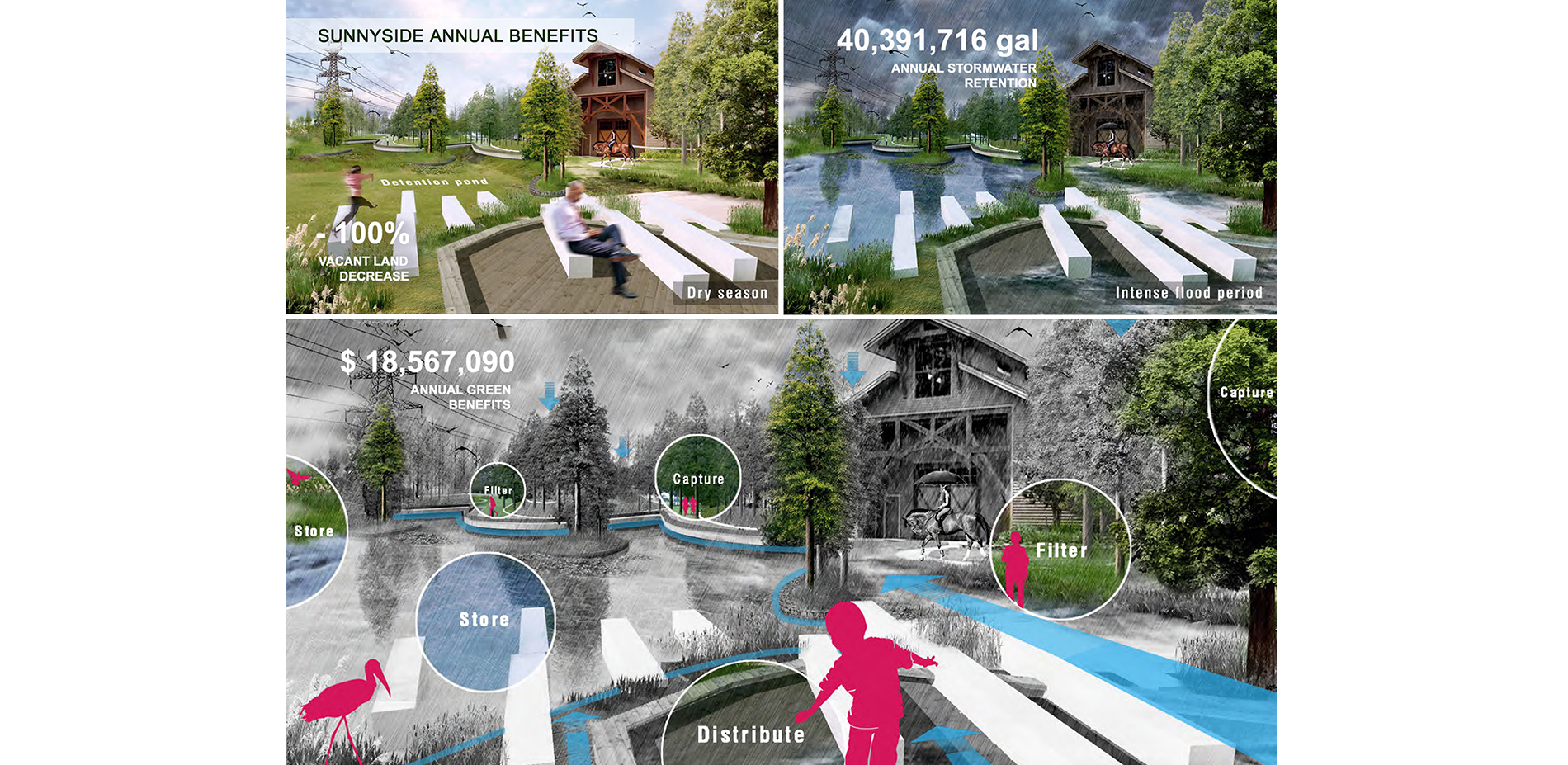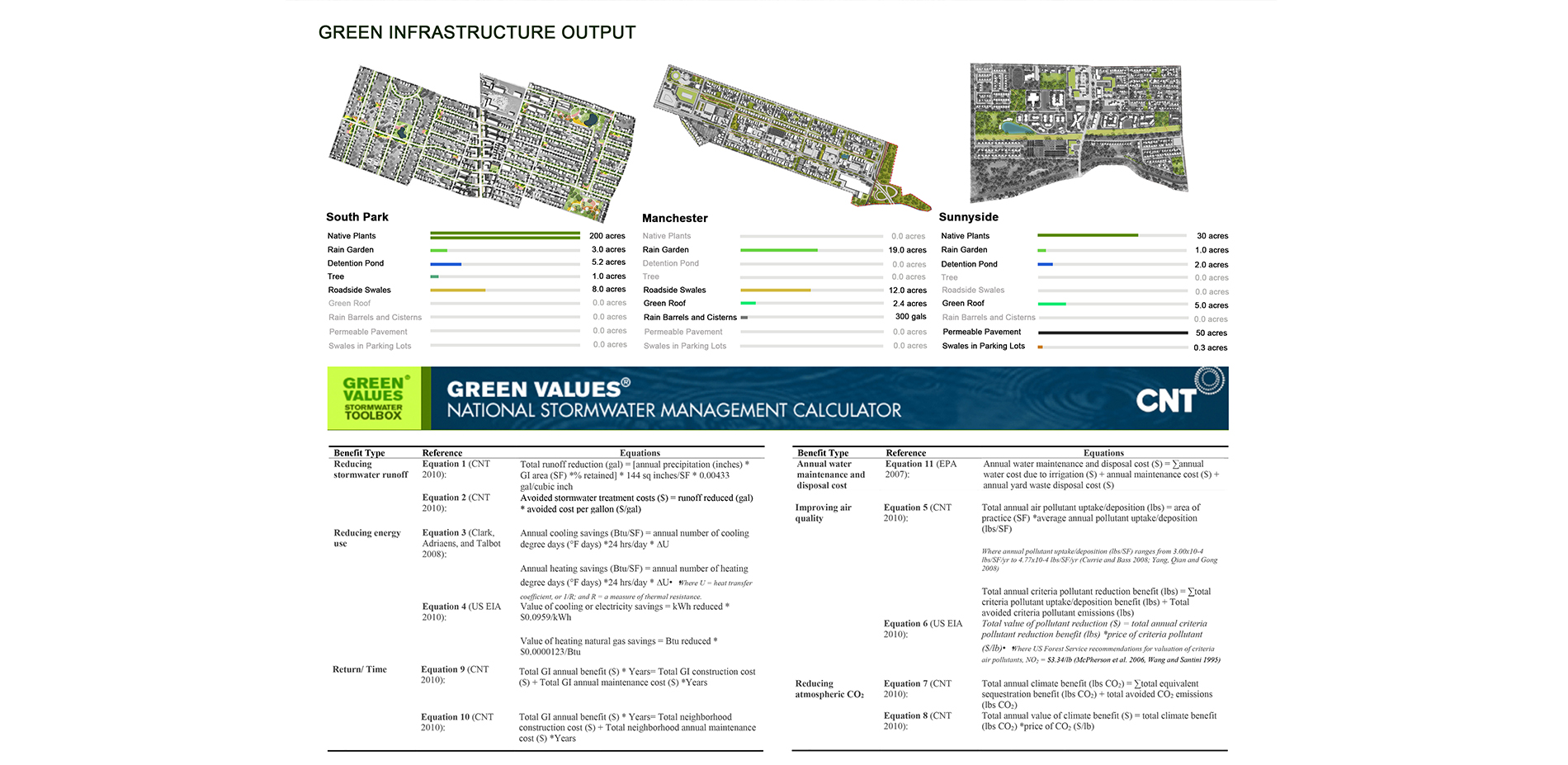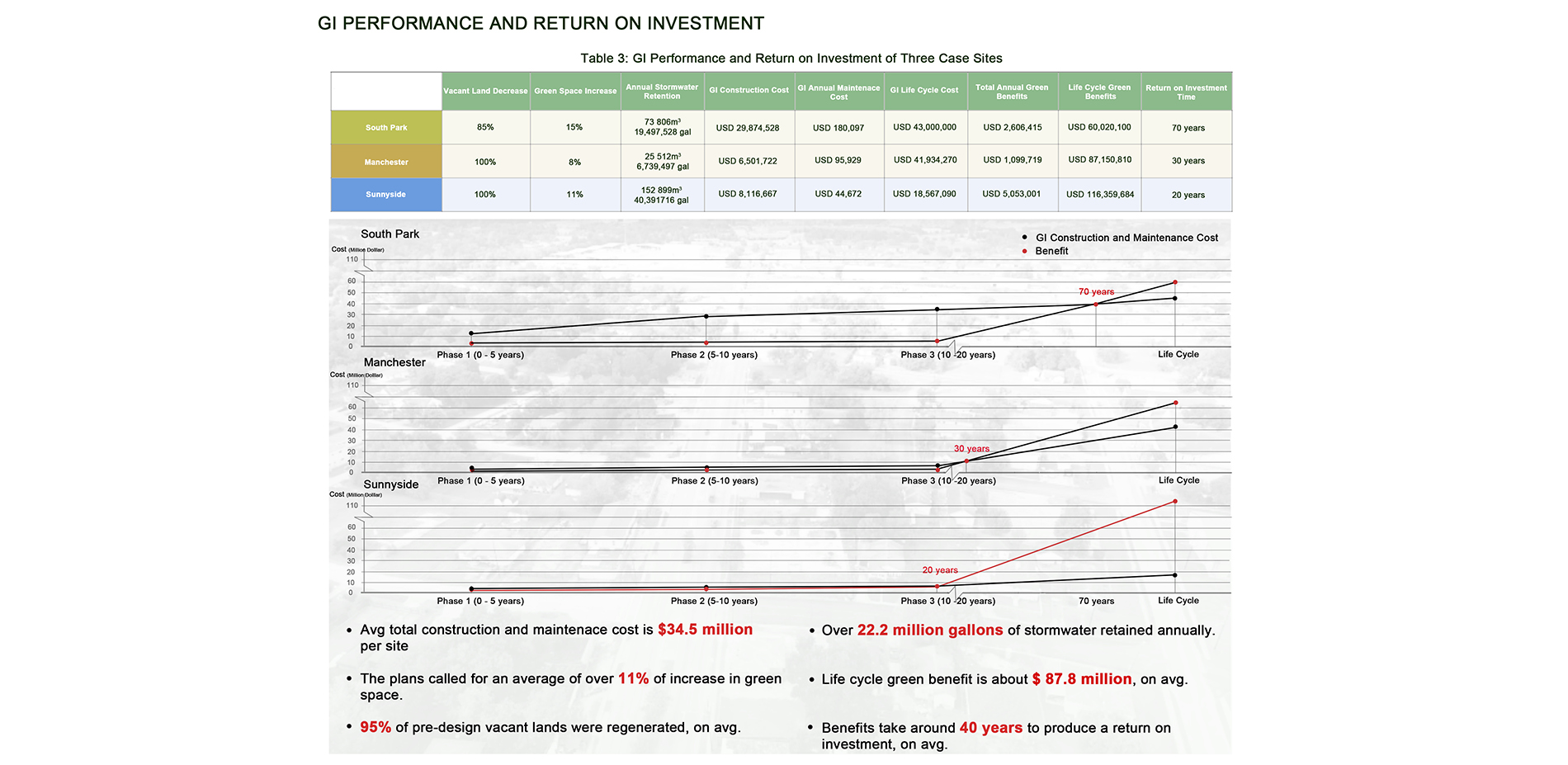Resilience Through Regeneration: The Economics of Repurposing Vacant Land with Green Infrastructure
Honor Award
Research
Xueqi Song; Dingding Ren; Rui Zhu, Student ASLA, Yangdi Wang
Faculty Advisors: Galen D. Newman, ASLA
Texas A&M University
Across three Texas cities—South Park, Manchester, and Sunnyside—this study looked at infill of vacant properties as a means of addressing flooding through green infrastructure. Various solutions were analyzed in terms of upfront costs and long-term economic benefit, with each of these cities potentially transforming large percentages of vacant land into stormwater retention ponds that would greatly reduce runoff while increasing green space as a public amenity. Detailed cost breakdowns show an average upfront cost of $34 million per site, with a life-cycle green benefit of more than $87 million, with a roughly 40-year return on investment.
- 2020 Awards Jury
Project Credits
Partner
Texas Environment Justice Advocacy Service
Partner
Charity Productions
Partner
Texas Target Communities
Partner
Texas A&M University Center of Housing and Urban Development
Partner
Texas A&M University Superfund Center
Project Statement
Many underserved urban areas affected by flood disasters are also becoming increasingly ecologically and socially fragmented due to the accumulation of vacant properties. These unused lots can potentially provide land for ecological/hydrological land uses. Despite overall population in-migrations in flood prone regions, many marginalized neighborhoods are characterized by excessive amounts of vacancies. Rather than chasing development-based incentives for regenerating vacant lots in these areas, a balance should be sought between new developmental land uses and green infrastructure (GI) to help counteract stormwater runoff and flood effects, or resilience through regeneration. This research asks, what are the economic costs and benefits of retrofitting GI into underserved communities as a strategy for vacant land regeneration. It uses landscape performance measures across three master plans for lower-income, minority dominant, flood-prone neighborhoods in Houston, Texas, USA to evaluate the economic and hydrologic impacts of GI regeneration projects. Results suggest that, when using this approach, 1) flood risk significantly decreases, 2) short term, upfront economic costs increase, and 3) the long-term economic return on investment is much higher.
Project Narrative
Introduction
Vacant land is a ubiquitous urban phenomenon (Pagano and Bowman, 2000). Small amounts of vacant lots can indicate healthy economic growth while larger proportions typically indicate urban decline (Hollander, 2010). Nearly 17% of each large U.S. cities’ land area is vacant, and this amount has increased by 1.3% since 1998 (Newman et al., 2016). When a flood disaster strikes, vacancies catapult (Ross 2013). The Texas coast is one of the most frequently impacted areas by flood disaster events globally. Houston, TX has one of the highest numbers of flood-related fatalities in the past 50 years (Highfield et al., 2013). From 2001 to 2017, Harris County incurred nearly 20 billion dollars in flood-related damages, including Hurricane Harvey. During Harvey, downtown Houston received 27 trillion gallons of rainwater (van Oldenborgh, 2017). Despite being one of the fastest growing cities in the U.S., Houston reports nearly 11% of its land as vacant (Newman et al., 2017). Many of the vacant properties are concentrated in marginalized communities, which are also more highly vulnerable to flooding than affluent communities (Sohn et al., 2014; Berke, 2015).
Objectives and Methods
Resilience through regeneration is an approach which mitigates flood effects in marginalized communities through focusing the repurposing efforts of vacant properties around green infrastructure (GI). Based on this approach, this research examines the economic costs and benefits of retrofitting GI as a strategy for vacant land regeneration. The research evaluates the performance of three plans using the resilience through regeneration approach in Houston, TX: South Park, Manchester, and Sunnyside. Each plan was created following a participatory design approach which utilized feedback loops between design personnel and community members. Then, we evaluated and compared the economic return and hydrologic benefits of each design. The impact evaluation utilizes consistent landscape performance tools to capture the hydrologic economic impacts across all three plans. The Center for Neighborhood Technology’s National Green Values Calculator (GVC), was used to compare costs, benefits, and performance of GI compared to conventional development practices (Foster et al., 2011). This tool has been used to assist in assessing the effectiveness of stormwater management practices on water quality (Liu, 2015), flood proofing (Wen, 2013), predict runoff capture (Carson et al. 2017), and evaluate stormwater runoff storage (Gittleman et al., 2017). The economic benefits were evaluated based on stormwater retention, carbon dioxide sequestration, reduced air pollutants, compensatory value of trees, groundwater replenishment, reduced energy use, and reduced treatment benefits.
Plan Evaluation Outcomes
South Park, TX
South Park, one of Houston’s oldest African-American neighborhoods, connects to the Gulf of Mexico, making it highly vulnerable to floods. Most of the flooding in South Park during Harvey occurred because of ineffective and outdated open ditch drainage infrastructure, not from bayou overtopping. During Hurricane Harvey, over 1/4 of the related flooding was outside the 100-year flood plain (van Oldenborgh, 2017). High vacancy rates have been a long-term problem in South Park. While the vacancy rate of Houston decreased from 20% to 11% from 2006 to 2017, South Park maintained a vacancy rate near 16%. Currently, a majority of its vacant lots have remained vacant for more than 3 years. The land value in these neighborhoods is 85% lower than the Houston average and 51% lower than Houston median. Also, over 90% of the residents are minority and 30% do not have high school degree. The plan, according to the GVC, projects that 85% of the site’s existing vacant lots will be regenerated and 90% of existing abandoned structures will be managed. Fifteen percent of the vacant properties will be regenerated into GI and 17 acres of new GI will be added. The GVC shows that this plan increases the permeable area by 15% and captures more than 45% of the runoff volume. Simultaneously, the design can capture 65,687,253ft3 of runoff, creating $2,606,415 in annual green benefits.
Manchester, TX
Manchester is surrounded by industries, and has one of the highest river impairments and lowest water qualities in the state. Local authorities provide sightseeing ventures named ‘Toxic Tours’ for visitors to raise awareness of the serious conditions in the neighborhood (Newman et al., 2016). Manchester has a large number of undocumented Hispanic immigrants and 1/3 of the residents live below poverty line (U.S. Census, 2010). The site is composed of 16% vacant parcels/abandoned structures; 68% of the neighborhood’s surface is currently impervious. After the plan is implemented, a majority of the existing underutilized parcels project to be regenerated. The amount of green space increases to nearly 7 times its current amount while the percentage of pervious surface increases from 36% to 51%. According to the GVC, over 40 million gallons of stormwater can be retained annually, with over $5,000,000.00 of annual green benefits generated from the GI.
Sunnyside, TX
Sunnyside is Houston’s oldest African-American neighborhood. It has one of the most socially vulnerable populations in the region and is currently 93% minority with many residents making less than $25,000 annually (U.S. Census, 2010). Due to ineffective engineered infrastructure, Sunnyside is severely impacted by large rainfall events. Fifty percent of the design site is within the 100-year floodplain. In order to avoid flooding, new construction in the site is built at a higher elevation, leading to increased flooding for existing housing. The GVC calculations show that overall, the ability of the proposed plan to capture runoff volume increased from 49.6% to 190.7%. One-hundred and forty-three acres of vacant space was regenerated, four times more walkable space was created, and dense canopy coverage increased from 23.9% to 39.8%.
Conclusions
This research determined the economic costs and benefits of retrofitting GI into underserved communities as a strategy for vacant land regeneration. Results show that, first, the ability to regenerate vacant properties is much easily performed. In fact, 95% of pre-design vacant lands were regenerated, on average, across all three sites. Because a large proportion of the repurposed vacant properties were not based on developmental pursuits, but GI, there is still room for development in these areas in the future if needed. The green spaces can provide temporary or permanent functions to assist with social or hydrological needs. Second, this increase in green space significantly assists in increasing stormwater retention. Across all sites, the plans called for an average of over 11% of increase in green space. This resulted in over 22.2 million gallons of stormwater retained annually. Third, the economic benefits created by this increase in green space and GI over a 100-year life cycle greatly outweigh the upfront construction and maintenance costs. With an average total cost (including construction and maintenance) of 34.5 million dollars but an 87.8 million dollar economic benefit across all three sites, findings suggest over 53 million more produced in life cycle benefits than upfront costs. These benefits generally take around 40 years to produce a return on investment. Construction costs appear to claim a bulk of the overall cost total. Green roofs have the highest overall costs to construct while rain gardens provide the most benefits for the least amount of cost efficiency. Costs are higher upfront, so marginalized communities will need to seek additional funding and phase in such projects. However, when using GI to assist in regenerating vacant properties, flood risk is shown to continually decrease. Also, while upfront economic costs increase in the short term, the long-term return on investment is much higher and the GI pays itself off through time.
